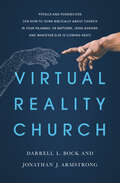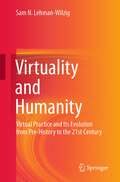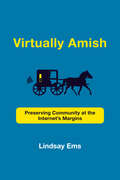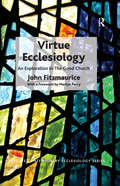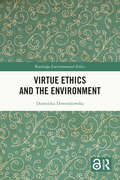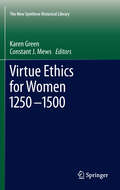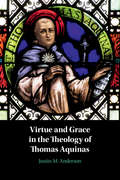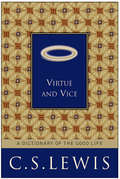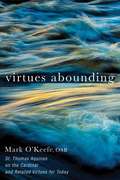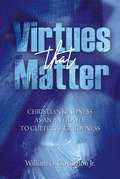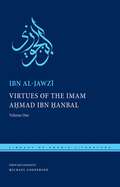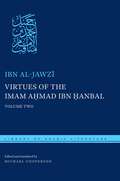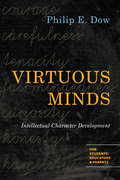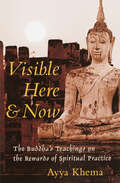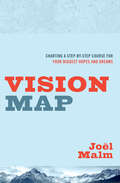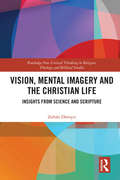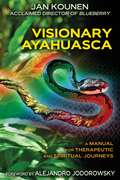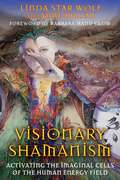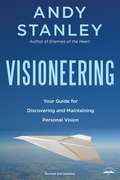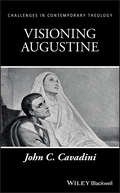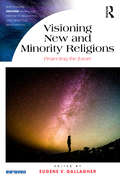- Table View
- List View
Virtual Reality Church: Pitfalls and Possibilities (Or How to Think Biblically about Church in Your Pajamas, VR Baptisms, Jesus Avatars, and Whatever Else is Coming Next)
by Darrell Bock Jonathan ArmstrongIs Virtual Reality a Biblical Reality?The invention of the printing press catalyzed Martin Luther&’s reformation; radios and televisions delivered Billy Graham&’s gospel proclamations to millions of households. Technological advancements have undoubtedly advanced kingdom work for centuries—but is the same true for the burgeoning technologies of today? As virtual reality becomes increasingly prominent throughout society, churches must assess how to respond thoughtfully and biblically. In Virtual Reality Church, theologians Darrell Bock and Jonathan Armstrong present a systematic reflection on how to faithfully apply virtual reality for ministry purposes. They examine the risks—like compromising the meaning of tangible worship—and opportunities—like safely reaching persecuted churches—of integrating revolutionary technologies into the Christian life. Learn to think critically, theologically, and pastorally about new technologies so that you can faithfully advance the gospel into the future.
Virtual Reality Church: Pitfalls and Possibilities (Or How to Think Biblically about Church in Your Pajamas, VR Baptisms, Jesus Avatars, and Whatever Else is Coming Next)
by Darrell Bock Jonathan ArmstrongIs Virtual Reality a Biblical Reality?The invention of the printing press catalyzed Martin Luther&’s reformation; radios and televisions delivered Billy Graham&’s gospel proclamations to millions of households. Technological advancements have undoubtedly advanced kingdom work for centuries—but is the same true for the burgeoning technologies of today? As virtual reality becomes increasingly prominent throughout society, churches must assess how to respond thoughtfully and biblically. In Virtual Reality Church, theologians Darrell Bock and Jonathan Armstrong present a systematic reflection on how to faithfully apply virtual reality for ministry purposes. They examine the risks—like compromising the meaning of tangible worship—and opportunities—like safely reaching persecuted churches—of integrating revolutionary technologies into the Christian life. Learn to think critically, theologically, and pastorally about new technologies so that you can faithfully advance the gospel into the future.
Virtuality and Humanity: Virtual Practice and Its Evolution from Pre-History to the 21st Century
by Sam N. Lehman-WilzigThis is a pioneering study of virtuality through human history: ancient-to-modern evolution and recent expansion; expression in many fields (chapters on Religion; Philosophy, Math, Physics; Literature and the Arts; Economics; Nationhood, Government and War; Communication); psychological and social reasons for its universality; inter-relationship with "reality." The book's thesis: virtuality was always an integral part of humanity in many areas of life, generally expanding over the ages. The reasons: 1- brain psychology; 2- virtuality's six functions — escape from boredom to relieving existential dread. Other questions addressed: How will future neuroscience, biotech and "compunications" affect virtuality? Can/should there be limits to human virtualizing?
Virtually Amish: Preserving Community at the Internet's Margins (Acting with Technology)
by Lindsay EmsHow the Amish have adopted certain digital tools in ways that allow them to work and live according to their own value system.The Amish are famous for their disconnection from the modern world and all its devices. But, as Lindsay Ems shows in Virtually Amish, Old Order Amish today are selectively engaging with digital technology. The Amish need digital tools to participate in the economy—websites for ecommerce, for example, and cell phones for communication on the road—but they have developed strategies for making limited use of these tools while still living and working according to the values of their community. The way they do this, Ems suggests, holds lessons for all of us about resisting the negative forces of what has been called &“high-tech capitalism.&” Ems shows how the Amish do not allow technology to drive their behavior; instead, they actively configure their sociotechnical world to align with their values and protect their community&’s autonomy. Drawing on extensive ethnographic fieldwork conducted in two Old Order Amish settlements in Indiana, Ems explores explicit rules and implicit norms as innovations for resisting negative impacts of digital technology. She describes the ingenious contraptions the Amish devise—including &“the black-box phone,&” a landline phone attached to a device that connects to a cellular network when plugged into a car&’s cigarette lighter—and considers the value of human-centered approaches to communication. Non-Amish technology users would do well to take note of Amish methods of adopting digital technologies in ways that empower people and acknowledge their shared humanity.
Virtue Ecclesiology: An Exploration in The Good Church (Routledge Contemporary Ecclesiology)
by John FitzmauriceCritiquing a paradigm of growth within the church, this book contends that the church’s growth ethic should be replaced by one based on virtue. Drawing on the work of Sennett, Fromm, and Hauerwas, John Fitzmaurice argues that an approach taking growth to be the overriding task of the church is found to be shallow and risks infantilising the faith it purports to proclaim. MacIntyre’s proposal for a recovery of a virtue-based ethic is examined and interpreted theologically through the concepts of narrative theology, community, sacraments and sanctification; the role of ’practices’ in developing virtuous character is central. The nature of a virtuous organisation is explored through a lens of organisational psychodynamics; this understanding informs a model of church as a community of interpretation. Fitzmaurice suggests that it is in and though sacramental practices that the transitional space for these virtues to be formed is created. Tracing a similar corrosion of character within secular institutions that have opted for an overriding focus on growth, this book offers an alternative based on the formation of corporate, as well as individual, virtuous character and considers the implications of a virtue-based growth ethic on theological education and ministerial formation as well as in terms of public theology and the manner of the church’s engagement with society.
Virtue Ethics and the Environment (Routledge Environmental Ethics)
by Dominika DzwonkowskaThis book addresses one of today’s most burning issues, namely the environmental crisis, by offering an insight into the problem from the perspective of virtue ethics.Virtue ethics is an approach to ethics that centralizes the concept of moral virtue, which can be extended to environmental ethics via environmental virtue ethics (EVE). Beginning with a comprehensive overview, the book explores the renaissance of contemporary virtue ethics and the beginnings of EVE in the second half of the 20th century and presents the main characteristics, proponents, and criticisms of EVE. The book then goes on to analyze its development by distinguishing the three most influential concepts: the classical; the naturalistic, teleological, and pluralistic; and the narrative conception of environmental virtue ethics. The author also discusses the most influential works on EVE, including a revision of Louke van Wensveen’s postulate to use virtue language in environmental ethics. By synthesizing such works on EVE alongside an analysis of the three most important concepts, the book offers a new concept that is universalistic, positive, and pragmatic.The book will be useful for students, scholars, and researchers studying environmental ethics, sustainable development, environmental psychology, moral philosophy, and philosophy of education.
Virtue Ethics for Women 1250-1500
by Karen Green Constant MewsThis book locates Christine de Pizan's argument that women are virtuous members of the political community within the context of earlier discussions of the relative virtues of men and women. It is the first to explore how women were represented and addressed within medieval discussions of the virtues. It introduces readers to the little studied Speculum Dominarum (Mirror of Ladies), a mirror for a princess, compiled for Jeanne of Navarre, which circulated in the courtly milieu that nurtured Christine. Throwing new light on the way in which Medieval women understood the virtues, and were represented by others as virtuous subjects, it positions the ethical ideas of Anne of France, Laura Cereta, Marguerite of Navarre and the Dames de la Roche within an evolving discourse on the virtues that is marked by the transition from Medieval to Renaissance thought. Virtue Ethics for Women 1250-1500 will be of interest to those studying virtue ethics, the history of women's ideas and Medieval and Renaissance thought in general.
Virtue and Grace in the Theology of Thomas Aquinas
by Justin M. AndersonThroughout his writings, Thomas Aquinas exhibited a remarkable stability of thought. However, in some areas such as his theology of grace, his thought underwent titanic developments. In this book, Justin M. Anderson traces both those developments in grace and their causes. After introducing the various meanings of virtue Aquinas utilized, including 'virtue in its fullest sense' and various forms of 'qualified virtue', he explores the historical context that conditioned that account. Through a close analysis of his writings, Anderson unearths Aquinas's own discoveries and analyses that would propel his understanding of human experience, divine action, and supernatural grace in new directions. In the end, we discover an account of virtue that is inextricably linked to his developed understanding of sin, grace and divine action in human life. As such, Anderson challenges the received understanding of Aquinas's account of virtue, as well as his relationship to contemporary virtue ethics.
Virtue and Vice
by C. S. LewisA Pocket Guide to Goodness Few writers have inspired more readers than author C. S. Lewis -- both through the enchanting volumes of his children's series and through his captivating adult classics such as Mere Christianity, The Screwtape Letters, The Great Divorce, and numerous others. Drawn from many works, this volume collects dictionary-like entries of Lewis's keenest observations and best advice on how to live a truly good life. From ambition to charity, despair to duty, hope to humility, Lewis delivers clear, illuminating definitions to live by.
Virtues Abounding: St. Thomas Aquinas On the Cardinal and Related Virtues for Today
by Mark O'KeefeThis book explores, in contemporary language, the practical insights that Aquinas offers for the moral life today. Whether in university, seminary, or adult faith formation settings—whether for a deeper intellectual understanding of virtues or for personal reflection and growth—Virtues Abounding will provide new insight into a classic but too often overlooked storehouse of moral riches.
Virtues That Matter: Christian Kindness as an Antidote to Cultural Crudeness
by William Covington JrCultural critics frequently point out how rude people have become. The need for patience, consideration and kindness is the mindset that provides the antidote to this cultural dysfunction. Christian virtues that enhance the quality of life for everyone, including both the initiators and receivers, are discussed in this book. Each chapter includes a reflection section that helps one apply the principles covered.Is it credible to claim that any reader of a book who applies the contents could enhance the quality of his own life as well as that of others with whom he interacts? This book examines issues that hold the potential for such direct far-reaching aims. Rather than curse the darkness of uncivil behavior in culture, this book shines light in providing an antidote that enhances the personal reputation of one interacting in the public sphere while making other people feel better that their lives have been touched in the process.Character is built on feeding one's mind the proper intellectual and spiritual content. Healthy relationships grow out of win/win exchanges. Having something of value to offer others grows out of an altruistic heart. Actions grow from thoughts. Mutually beneficial dealings leads to a higher quality of life for everyone involved.Virtues taught by Jesus have been the antidote to self-serving narcissistic thinking everywhere they're been applied. Fulfillment comes from extending one's focus beyond self-gratification. Each chapter ends with a series of reflection questions which helps a person gain perspective on how these principles apply to him personally and how they can be applied for a higher standard of living for self and others.
Virtues of the Imam Ahmad ibn Ḥanbal: Volume One (Library of Arabic Literature #50)
by Ibn al-JawzīAḥmad ibn Ḥanbal (d. 241/855), renowned for his profound knowledge of hadith—the reports of the Prophet’s sayings and deeds—is a major figure in the history of Islam. Ibn Ḥanbal’s piety and austerity made him a folk hero, especially after his principled resistance to the attempts of two Abbasid caliphs to force him to accept rationalist doctrine. His subsequent imprisonment and flogging became one of the most dramatic episodes of medieval Islamic history. Ibn Ḥanbal’s resistance influenced the course of Islamic law, the rise of Sunnism, and the legislative authority of the caliphate. Virtues of the Imam Aḥmad ibn Ḥanbal is a translation of the biography of Ibn Ḥanbal penned by the Baghdad preacher, scholar, and storyteller, Ibn al-Jawzī (d. 597/1201). It includes insights into Ibn Ḥanbal’s childhood, travels, and teachings, as well as descriptions of his way of life. Volume One presents the first half of the text, offering insights into Ibn Ḥanbal’s childhood, education, and adult life, including his religious doctrines, his dealings with other scholars, and his personal habits. Set against the background of fierce debates over the role of reason and the basis of legitimate government, Virtues of the Imam Ahmad ibn Ḥanbal tells the formidable life tale of one of the most influential Muslims in history.A bilingual Arabic-English edition.
Virtues of the Imam Ahmad ibn Ḥanbal: Volume Two (Library of Arabic Literature #44)
by Ibn al-JawzīAḥmad ibn Ḥanbal (d. 241/855), renowned for his profound knowledge of hadith—the reports of the Prophet’s sayings and deeds—is a major figure in the history of Islam. Ibn Ḥanbal’s piety and austerity made him a folk hero, especially after his principled resistance to the attempts of two Abbasid caliphs to force him to accept rationalist doctrine. His subsequent imprisonment and flogging became one of the most dramatic episodes of medieval Islamic history. Ibn Ḥanbal’s resistance influenced the course of Islamic law, the rise of Sunnism, and the legislative authority of the caliphate. Virtues of the Imam Aḥmad ibn Ḥanbal is a translation of the biography of Ibn Ḥanbal penned by the Baghdad preacher, scholar, and storyteller, Ibn al-Jawzī (d. 597/1201). It includes insights into Ibn Ḥanbal’s childhood, travels, and teachings, as well as descriptions of his way of life. This second and final volume gives a vivid account of Ibn Ḥanbal’s legendary confrontation with the caliphal Inquisition, including his imprisonment, trial, and flogging. Ultimately, it recounts how the people of Baghdad came to admire him as a symbol of Sunni Islam. A bilingual Arabic-English edition.
Virtuous Minds: Intellectual Character Development
by Philip E. DowTempleton Foundation Character Project's Character Essay and Book Prize Competition award winner What does it mean to love God with all of our minds? Our culture today is in a state of crisis where intellectual virtue is concerned. Dishonesty, cheating, arrogance, laziness, cowardice--such vices are rampant in society, even among the world?s most prominent leaders. We find ourselves in an ethical vacuum, as the daily headlines of our newspapers confirm again and again. Central to the problem is the state of education. We live in a technological world that has ever greater access to new information and yet no idea what to do with it all. In this wise and winsome book, Philip Dow presents a case for the recovery of intellectual character. He explores seven key virtues--courage, carefulness, tenacity, fair-mindedness, curiosity, honesty and humility--and discusses their many benefits. The recovery of virtue, Dow argues, is not about doing the right things, but about becoming the right kind of person. The formation of intellectual character produces a way of life that demonstrates love for both God and neighbor. Dow has written an eminently practical guide to a life of intellectual virtue designed especially for parents and educators. The book concludes with seven principles for a true education, a discussion guide for university and church groups, and nine appendices that provide examples from Dow?s experience as a teacher and administrator. Virtuous Minds is a timely and thoughtful work for parents and pastors, teachers and students--anyone who thinks education is more about the quality of character than about the quantity of facts.
Visible Here and Now: The Buddha's Teachings on the Rewards of Spiritual Practice
by Ayya KhemaThis practical commentary on one of the most important scriptures of the Pali canon will provide essential sustenance for Buddhist practitioners. Ayya Khema is a mountain of strength, encouragement, and tough love as she pours out down-to-earth practical instruction on the journey to enlightenment, following the framework set forth in the Samannaphala-sutta, the Buddha's discourse on the rewards of spiritual life. The sutta—included here in the translation by Bhikkhu Bodhi—contains the Buddha's teachings in response to questions posed by King Ajatasattu. Why, the king asked, should we give up the satisfactions of worldly life and devote ourselves to meditation? What are the tangible benefits to be gained from following the Buddha's way? In answering this question, the Buddha provides a compact synopsis of the entirety of the spiritual path, and Ayya Khema expands on this with her characteristic approach—simple, direct, experiential, and loving. An important aspect of the sutta is an account of the eight meditative absorptions, or jhanas—states of mind that bring joy, serenity, and peace and that open the way to clarity and liberation. Ayya Khema, who was herself adept at the eight absorptions, confidently leads the reader to, through, and beyond the jhanas, following the Buddha's plan. Her words have the effect of inspiring us to roll up our sleeves and get to work so that we may grasp the insights, accomplish the meditative goals, and become enlightened to the highest extent of our talents and efforts.
Vision Map: Charting a Step-by-Step Course for Your Biggest Hopes and Dreams
by Joel MalmIs there a gap between you and your dream?A few years back, Joël Malm had the idea to lead people on outdoor expeditions with a spiritual, God-centered focus. Following God&’s lead, he created a vision map, started his organization, and made it happen.This book is a response to the question he often gets: How do you do something like that?Whether you want to start a business, raise a family, run a marathon, plant a church, restore a relationship, or climb a mountain, you can take practical steps to see your vision come to be.Vision Map is not a formula for overnight success, but it is a template to start anyone on the path to envisioning a God-given dream. God often gives us a difficult problem to solve, and we just need a push in the right direction to find the answer.
Vision Map: Charting a Step-by-Step Course for Your Biggest Hopes and Dreams
by Joel MalmIs there a gap between you and your dream?A few years back, Joël Malm had the idea to lead people on outdoor expeditions with a spiritual, God-centered focus. Following God&’s lead, he created a vision map, started his organization, and made it happen.This book is a response to the question he often gets: How do you do something like that?Whether you want to start a business, raise a family, run a marathon, plant a church, restore a relationship, or climb a mountain, you can take practical steps to see your vision come to be.Vision Map is not a formula for overnight success, but it is a template to start anyone on the path to envisioning a God-given dream. God often gives us a difficult problem to solve, and we just need a push in the right direction to find the answer.
Vision, Devotion, and Self-Representation in Late Medieval Art
by Alexa SandThis book investigates the "owner portrait" in the context of late-medieval devotional books primarily from France and England. These mirror-like pictures of praying book owners respond to and help develop a growing concern with visibility and self-scrutiny that characterized the religious life of the laity after the Fourth Lateran Council in 1215. The image of the praying book owner translated preexisting representational strategies concerned with the authority and spiritual efficacy of pictures and books, such as the Holy Face and the donor image, into a more intimate and reflexive mode of address in Psalters and Books of Hours created for lay users. Alexa Sand demonstrates how this transformation had profound implications for devotional practices and for the performance of gender and class identity in the striving, aristocratic world of late medieval France and England.
Vision, Mental Imagery and the Christian Life: Insights from Science and Scripture (Routledge New Critical Thinking in Religion, Theology and Biblical Studies)
by Zoltán DörnyeiThis book uniquely explores how the notion of vision is presented in modern science and the Bible, and how it can be applied to contemporary Christian contexts. The word "vision", our ability to see, has been described by an increasing body of scholarship in the social sciences as our capacity for mental imagery and imagination. As such, this unique cognitive capability has been utilised in many fields for a variety of purposes, from arts and psychotherapy to politics and business management, and even for performance enhancement in sports. The current book argues that a better understanding of vision can have far-reaching practical implications for Christian life and ministry by helping people to align themselves with God’s specific purposes. After a theoretical overview that integrates scientific and theological insights, the final chapters present a variety of strategies that can help believers to discern God’s call through the use of mental imagery and then to develop and cultivate the perceived vision. The book examines the scientific and biblical principles of vision in a comprehensive manner, with a special emphasis on the practical implications of the issue. As such, it will be of great interest to scholars of Theology, Biblical Studies and Church Growth/Leadership, as well as Organisational Behaviour, Business Management and Psychology.
Visionary Ayahuasca: A Manual for Therapeutic and Spiritual Journeys
by Alejandro Jodorowsky Jan KounenA “what to expect” guide for first-time ayahuasca users paired with accounts from the author’s extensive shamanic experiences in the Amazon • Describes how to prepare for the first ceremony, what to do in the days afterward, and how to maintain a shamanic healing diet • Details some of the author’s own ayahuasca experiences, including an intensive trip in 2009 when he underwent 17 ceremonies • Explores the many other plants that are part of the ayahuasca healer’s medicine cabinet as well as the icaros, healing songs, of the ayahuasca shaman Since 1999 Jan Kounen has regularly traveled to the Peruvian Amazon to participate in ayahuasca ceremonies. At first only a curious filmmaker, over multiple trips he transformed from explorer to apprentice to ayahuasquero and often found himself surrounded by other foreigners coming to the jungle for their first taste of ayahuasca medicine. Knowing how little guidance is available on how to prepare or what to expect, he naturally offered them advice. Part visionary ayahuasca memoir and part practical guide, this book contains the same step-by-step advice that Kounen provides first-time ayahuasca users in the jungle. He describes how to prepare for the first ceremony and what to do in the days afterward. He explores how to deal with the nausea and details the special preparatory diets an ayahuasca shaman will put you on, often lasting for months but necessary for life-transforming results and teachings from the plant spirits. He also explains how it is far easier to maintain these restrictions in the jungle than in the city. Detailing his own ayahuasca experiences over hundreds of sessions, including a trip in 2009 when he underwent 17 ceremonies in 25 days, Kounen describes how ayahuasca transformed him. He tells of his meetings with Shipibo healers, including Kestenbetsa, who opened the doors of this world for him, and Panshin Beka, the shaman to whom Kounen became an apprentice. He details the many other plants and foods that are part of the ayahuasca healer’s medicine cabinet, such as toé and tobacco, as well as their icaros, or healing songs. A veritable “what to expect” guide, this book should be your first step prior to committing to ayahuasca.
Visionary Shamanism: Activating the Imaginal Cells of the Human Energy Field
by Linda Star Wolf Barbara Hand Clow Anne DillonShamanic practices to access your spiritual blueprint, communicate with the universal mind, and transform in to your highest spiritual self • Explains how to tune in to imaginal cells to heal the past, activate the shaman within, and download information from the future • Includes shamanic breathwork practices and rituals to open access to your spiritual blueprint--the hologram of who your highest, best self is meant to be--and be more potent and powerful in the present We are in a highly transitional time on Earth as old structures break down in preparation for the new world that is coming. The accelerated pace of this time of spiritual evolution is forcing each of us to awaken the shaman within and reach our highest potential as quickly as possible. We no longer have the luxury of learning only from the past--we must also download information from the future in order to be fully present, fully conscious, in our most embodied and best self now. Incorporating the wisdom teachings of Seneca Wolf Clan Grandmother Twylah Nitsch with shamanic journeys and shamanic breathwork practices, Linda Star Wolf and Anne Dillon explain how to heal the past, learn from the future, and activate the imaginal cells within our human energy field. Imaginal cells are the energies of what has already happened and will happen stored in the blueprint of the invisible world. By tuning in to these imaginal cells, you can open access to your spiritual blueprint--the hologram of who your highest, best self is meant to be--and accelerate your evolutionary potential in this lifetime. Including information received by Star Wolf from the future, the book explores how to develop a communication link with the universe, receive guidance from the universal mind, and draw information from the future to be more potent and powerful in the present, live in harmony with one another and the planet, and fully prepare yourself for the new world to come.
Visioneering: Your Guide for Discovering and Maintaining Personal Vision
by Andy StanleyLift Your Vision High Vision is a preferred future. A destination. Vision always stands in contrast to the world as it is. Visioneering, according to bestselling author Andy Stanley, is "a clear mental picture of what could be, fueled by the conviction that it should be." With warm, down-to-earth practicality, Andy Stanley explores the ordinary life of Nehemiah and his God-given vision for accomplishing the extraordinary. He shows how the life of this great ancient visionary, determined to rebuild the ruined walls of Jerusalem, reveals principles that can prepare us to find and follow God's multifaceted vision for our own lives. Now this bestseller is again available in an attractive, affordable paperback!Everybody ends up somewhere in life. You can end up somewhere on purpose! Visioneering is the engineering of a vision. It's the process one follows to develop and maintain vision. "Vision," writes Andy Stanley , "is a clear mental picture of what could be, fueled by the conviction that it should be." In the bestselling Visioneering, Stanley builds a compelling case for the necessity of a clear, God-ordained vision for each of the roles of your life. Whether you're a parent with a vision for your children or a CEO pursuing a corporate vision, Visioneering is the perfect tool to help you develop and maintain God's unique purpose for your life.
Visioning Augustine (Challenges in Contemporary Theology)
by John C. CavadiniThe definitive compendium of Cavadini’s essays on Augustine Visioning Augustine offers readers an expertly selected collection of essays exploring the text and history of the theology of Saint Augustine. Prominent scholar and essayist, John Cavadini, offers modern audiences an innovative framework for understanding Augustine, integrating articles and essays on significant texts, historical and contemporary perspectives and insights into Augustine’s development as a theologian. Examining themes such as the transformation of the human will in De doctrina Christiana and Augustine’s critique of philosophy in City of God, Cavadini provides clear and accessible smaller-size essays that serve as entry points for those interested in Augustinian scholarship. The author’s meditations on Augustinian texts invite readers to re-evaluate their interpretations and learn about the subtle and sophisticated vocabulary of Augustine. An encounter with Augustine the Christian theologian, Cavadini contends, is not a narrowly focused parochial experience, but instead a challenge to enlarge our horizons. Written by one of the most prominent Augustinian scholars and essayists in the field Addresses ecumenical and cultural issues that weaken contemporary interest in Christian faith Offers modern readers historical context on Augustinian theology Provides a single-volume collection of Cavadini’s essays on Augustine written over the course of more than two decades Accessible prose and intellectual sensitivity to modern theological problemsmake Visioning Augustine an indispensable volume for graduate students, scholars and professionals in all areas of Christian theology.
Visioning New and Minority Religions: Projecting the future (Routledge Inform Series on Minority Religions and Spiritual Movements)
by Eugene V. GallagherRather than being ephemeral fads, new religious movements (NRMs) have always been and will always be with us. So will their study. Offering an assessment of the state-of-the-field of the study of NRMs, Visioning New and Minority Religions begins by considering the analytical tools for the study of new or minority religions, drawing on the perspectives of diverse academic disciplines. The second part focuses on individual groups in a variety of geographical settings. Chapters in this section review the histories of particular groups in order to extrapolate future developments. They cover new religions that have persisted well past the first generation, such as the Church of Jesus Christ of Latter-day Saints and the Christian Scientists, and groups with comparatively shorter histories, such as various forms of contemporary Paganism, Soka Gakkai, and the Diamond Way Buddhist group. This volume will be of interest to scholars from across religious studies and sociology, as well as members of new and minority religious groups and those in "cult watching" groups.
